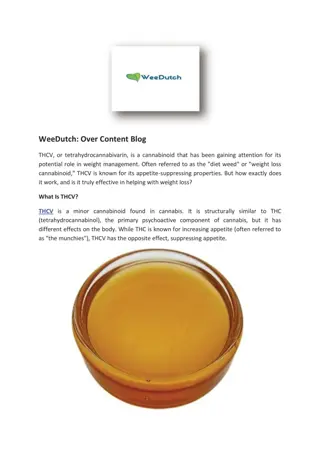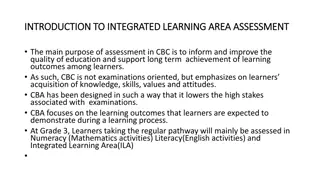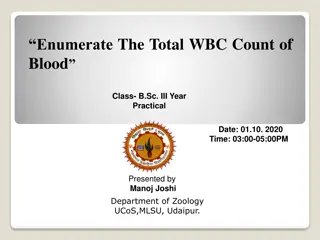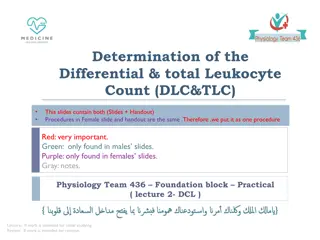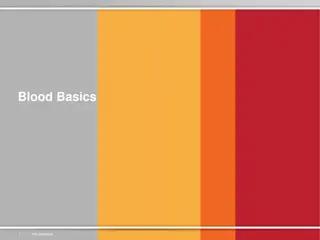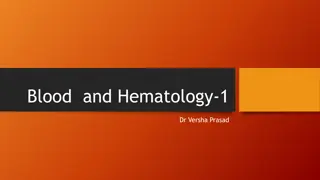Understanding Complete Blood Count (CBC) Test
Complete Blood Count (CBC) is a panel of tests that evaluates different types of blood cells, including red blood cells, white blood cells, and platelets. CBC helps diagnose various blood disorders and monitor conditions that affect blood cells, such as anemia or infections. The test is ordered based on symptoms like fatigue, weakness, infections, or as a routine check for certain diseases or during treatments like chemotherapy. CBC can be done manually or automated using flow cytometry technology, providing valuable information about cell counts and types in the blood sample.
Download Presentation

Please find below an Image/Link to download the presentation.
The content on the website is provided AS IS for your information and personal use only. It may not be sold, licensed, or shared on other websites without obtaining consent from the author. Download presentation by click this link. If you encounter any issues during the download, it is possible that the publisher has removed the file from their server.
E N D
Presentation Transcript
http://www.healthcentral.com/common/images/1/15329_21632_5.jpghttp://www.healthcentral.com/common/images/1/15329_21632_5.jpg
1. To estimate the number of RBC in blood sample 2. To estimate the number of total WBC in blood sample 3. To perform a differential count for a blood sample
A CBC is a panel of tests that evaluates the three types of cells that circulate in the blood. CBC RBC WBC Platelets Red Blood Cell Count White Blood Cell Count Platelet count Hemoglobin White Blood Cell Differential Mean platelet volume (MPV) Hematocrit Mean Corpuscular Volume Mean Corpuscular Hemoglobin Etc
When Is It Ordered When a person has any number of signs and symptoms that may be related to disorders that affect blood cells. When an individual has fatigue or weakness or has an infection, inflammation, bruising, or bleeding, a health practitioner may order a CBC to help diagnose the cause and/or determine its severity. When a person has been diagnosed with a disease known to affect blood cells, a CBC will often be ordered on a regular basis to monitor their condition. Some therapies, such as chemotherapy, can affect bone marrow production of cells. A CBC may be ordered on a regular basis to monitor these drug treatments.
CBC can applied by two ways: Manual blood count Automated blood count
http://a.static-abcam.com/CmsMedia/Media/flowcytometry01472px.jpghttp://a.static-abcam.com/CmsMedia/Media/flowcytometry01472px.jpg 1-Automated Blood Count: CBC is performed by an automated analyzer that counts the numbers and types of different cells within the blood. It aspirates a very small amount of the sample through the narrow tubing. Within this tubing, there are sensors that count the number of cells going through it, and can identify the type of cell; this is called flow-cytometry.
2-Manual blood count This measurement is made with a microscope and a specially ruled chamber (hemocytometer) using diluted blood.
(A) Red blood count It is test done to determination the number of RBC in a sample of blood , also it evaluate the size and shape of RBC It is range from 4.2 5.5 million RBC per cubic millimeter (mm ) It is considered a very important indicator of a patent s health High RBC count Low RBC count Polycythemia Anemia Congenital heart disease Acute or chronic blood loss Renal problem Malnutrition Chronic inflammation
Normally high (RBC count) People who live at high altitudes Oxygen is low RBC synthesis increases Smokers Principle : The process involves by counting cells in several squares of the grid and obtain an average number, this number is multiply by a factor that compensates the amount of dilution. The final results expresses the number of RBC /mm of original blood sample.
(B) WBC count : Total leukocytes count shows the number of WBC in a sample of blood . A normal WBC count is between 4,500 and 11,000 cells per cubic millimeter . The number of WBC is sometimes used to identify an infection or to monitor the body s response to treatment. Low WBC count A Condition in which the number of leukocytes is abnormally low and which is Leukopenia most commonly due to sever infections (such as HIV) and radiation poisoning. High WBC count A condition characterized by an elevated the number of WBC occur as a result Leukocytosis of an infection, or cancer (Leukemia). It can occur normally after eating fat-rich meals .
Principle: It is necessary to obtain RBC free preparation of WBC from blood . Suspension of the red blood cell in a very hypotonic solution will lead to the destruction of RBC .
Calculations: RBC blood cell count ( 5 squares) Find the sum of RBCs in 5 large squares, and divide it with 80 (5 X 16) small squares to find the average in one square, multiply it by 200 to allow for the dilution and then multiply by 4000 to obtain the number per cubic milliliter. The sum of RBCs in 5 large squares = 84+71+63+93+83= 394 cells. The average of RBCs in one square= 394/80 = 4.9 cells. RBC count= 4.9 x 200 x 4000 = 4 million/mm3. Normal range= 4.2-5 million/mm3
WBC blood cell count ( 4 squares) Find the sum of WBCs in 4 large squares, and divide it with 64 (4 X 16) small squares to find the average in one square, multiply it by 20 to allow for the dilution and then multiply by 160 to obtain the number per cubic milliliter. The sum of WBCs in 4 large squares = 16+21+17+15= 69 cells. The average of WBCs in one square= 69/64 = 1.07 cells. WBC count= 1 x 20 x 160 = 3200 Cells/mm3. Normal range= 4500-11000 cells /mm3
(C) Differential Count It determinesthenumberofeachtypeofWBCpresentintheblood
Principle: Classification of polymorphonuclear granulocytes (PMN) is based on the size , shape , number and staining characteristics of their granules . Leishman s stain It is based on a mixture of methylene blue and eosin. It differentiates between WBC as indicated in the following table:






